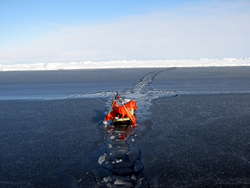Dangers Arctic Ocean: Open water leads
The leads are very dangerous.

You will last for only a few minutes in the water. At first you'll feel pretty alright, swimming a few strokes trying to estimate the sudden situation, but soon enough a horrible cold will overcome you as the water in an instant flushes your clothes. Next your boots will fill up dragging you down and panic will enter.
You will do a few attempts to get up, but the ice is slippery and the edges frail, braking away with your weight at each push. Now you'll sense a strange fatigue and your attempts become increasingly weak. Thoughts will swirl through your mind in a crescendo of memories as your mind scan itself in a desperate search for related information that could prove helpful.
– “So this is the end”, you finally register to yourself and with a strange feeling of peace and sadness, you'll accept your fate and disappear under the ice.
Yet it is not the end unless you give up. Survival is a decision. The difference is a firm determination to get up and just a few more pushes. Take it from an expert and remember it. Get up! GET UP!!
Yet there are several ways to not get yourself into this situation in the first place. Rule number one is to always wear skis while traveling. The skis will distribute your weight very efficiently.

If you must travel over very thin ice, wear a dry suit. Avoid thin ice altogether (holding for less than 2 pokes with your ski pole) unless you really don't have a choice. This danger is especially typical to the late season and unsupported expeditions as they are forced to travel at a slow pace.
The greatest danger is crossing thin ice over wide leads. If you fall through, there will be nothing to get back up on except for weak pans of thin ice. You will not be able to swim or paddle through them as they will pile up between you and the shore. You run a great risk of getting stuck, even if you should manage to get back up on the sled. Avoid crossing those kinds of areas by all means!
If you swim or paddle leads, make an escape plan beforehand. Enter the water from a low and stable piece of the ice, should the other shore prove too weak for your exit out of the water you can always go back to where you started. If you are two or more in the expedition, always let one wait on the starting shore until the other is standing safely on the other side.

Swimming leads is fairly easy if the lead is “clean”, meaning low edges of firm ice and open water. Paddling them on top of your sled is actually a nice break to the skiing and very helpful as crossings over ice bridges often involve skiing deep into rubble and then again back out of the rubble. If you paddle the lead you can instead get in from a nice flat pan and get out on another nice flat pan.
The paddling/swimming gets trickier later in the season. The shores become very unstable and the leads will be a maze of floating ice chunks. Getting into such a lead is really no fun. The leads are often triggered into motion with your arrival in them. The ice chunks will start to corner you and the lead might begin to close up with you inside it. You will try to get up on the floating ice islands but they will be all soft and mushy and break under you. If you get caught by the closing ice, you will get stuck.
There is only one advice for this situation – don't enter bad leads. Those leads often separate two new ice ridges on each side or form lakes of an icy soup. Take the time instead to travel along them until you find a firm and safe passage.

Another hazard of paddling leads late in season are big ice chunks breaking off from under the shore as you grab at it, hitting the sled from below. Paddle to firmer ice or get back to your starting point and try another entry point.
Always wear a dry suit when paddling/swimming a lead and practice the procedure before the expedition. Paddling and swimming in a dry suit on top of a sled is trickier than it seems. The dry suit is very bulky, your hands are covered and the suit might leak. The sled is very wobbly and prone to turn over in the water. If it does you'll lose your gear and then you are in real trouble. It will take days for people to search for you and if you have lost all your gear you'll simply freeze to death while waiting.
If you go on an air-supported expedition you'll probably travel fast enough to be able to stay out of the water altogether. The ice will be frozen over for the most part of your journey and your ride will be a lot safer. Don't lag behind if you have this opportunity to stay out of trouble.